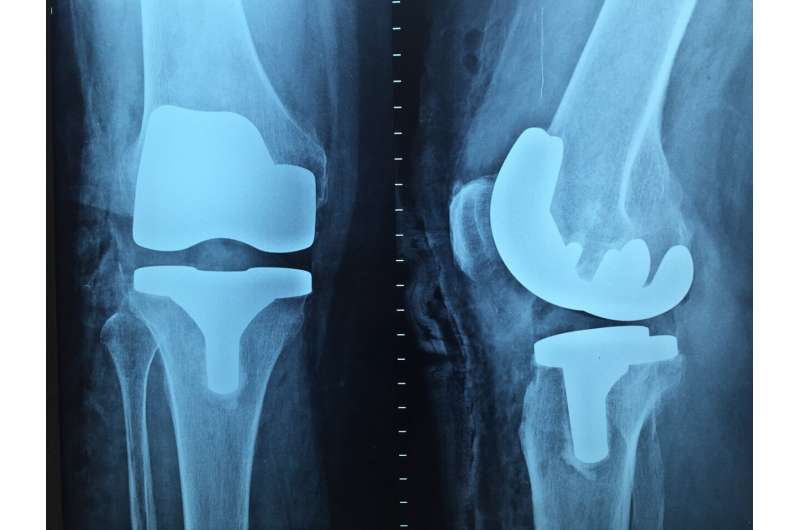This article has been reviewed according to Science X's editorial process and policies. Editors have highlighted the following attributes while ensuring the content's credibility:
fact-checked
peer-reviewed publication
trusted source
proofread
Lab values predict periprosthetic joint infection in patients with morbid obesity

For patients with severe obesity undergoing knee or hip replacement, commonly obtained laboratory values—including markers of anemia and inflammation—are independent predictors of the risk of periprosthetic joint infection (PJI), reports a study in The Journal of Bone & Joint Surgery.
Hemoglobin level, platelet count, and several markers of systemic inflammation may be relevant to the elevated rates of PJI following total joint arthroplasty among patients with a body mass index (BMI) of 40 kg/m2 or higher, according to the new research by Nathanael D. Heckmann, MD, and colleagues of Keck School of Medicine of the University of Southern California, Los Angeles.
"These findings may help surgeons risk-stratify morbidly obese patients, who represent a growing high-risk TJA population," the researchers write.
New data on laboratory predictors of PJI in morbid obesity
An increasing proportion of patients undergoing total hip or knee arthroplasty have morbid obesity. Many studies have found that these patients are at an elevated risk of PJI, up to five times higher than in normal-weight patients. Dr. Heckmann and colleagues sought to identify preoperative laboratory markers associated with an increased risk of PJI among patients with morbid obesity.
The analysis included 6,780 patients with a BMI of 40 or higher who underwent total knee or hip arthroplasty, as identified with use of data from a national insurance claims database. The analysis focused on laboratory values relevant to proposed mechanisms of increased PJI risk associated with morbid obesity.
Several laboratory values were associated with increased rates of developing PJI within 90 days postoperatively. Compared to an overall rate of 0.69%, PJI developed in 1.69% of patients with hemoglobin levels indicating anemia and in 2.14% of patients with abnormal (high or low) platelet counts.
'Critical importance' of assessing anemia before arthroplasty
Elevated levels of certain complete blood count (CBC)–based ratios indicating systemic inflammation were also linked to increased risk of PJI, including 1.11% for an increased neutrophil-lymphocyte ratio, 1.69% for an increased platelet-lymphocyte ratio, and 1.05% for an increased systemic immune-inflammation index.
After adjusting for potential confounders, all of these preoperative laboratory markers were independently associated with PJI risk. Odds ratios were 2.62 for hemoglobin, 3.50 for platelets, 2.38 for neutrophil-lymphocyte, 4.86 for platelet-lymphocyte ratio, and 2.44 for systemic immune-inflammation index.
Several comorbid conditions were more common in patients with PJI, including chronic pulmonary disease, complicated diabetes, and complicated hypertension. In contrast with previous reports, albumin and glycated hemoglobin levels were not associated with PJI risk.
Within the limitations of the retrospective study, the findings help to address the "paucity of data" regarding factors contributing to the elevated risk of PJI associated with morbid obesity. Added to previous studies, the findings suggest that the association between anemia and PJI is even stronger among patients with severe obesity, compared with the general population.
"This heightened risk signifies the critical importance of identifying anemia in morbidly obese patients to effectively assess PJI risk prior to TJA," the researchers write.
However, more research will be needed to confirm the impact of preoperative platelet count and complete blood count–based ratios on PJI risk.
Dr. Heckmann and co-authors conclude, "Additional prospective studies should be conducted to validate the clinical utility of these laboratory markers to help risk-stratify morbidly obese patients prior to elective TJA."
More information: Preoperative Laboratory Values Predicting Periprosthetic Joint Infection in Morbidly Obese Patients Undergoing Total Hip or Knee Arthroplasty, Journal of Bone and Joint Surgery (2024).


















